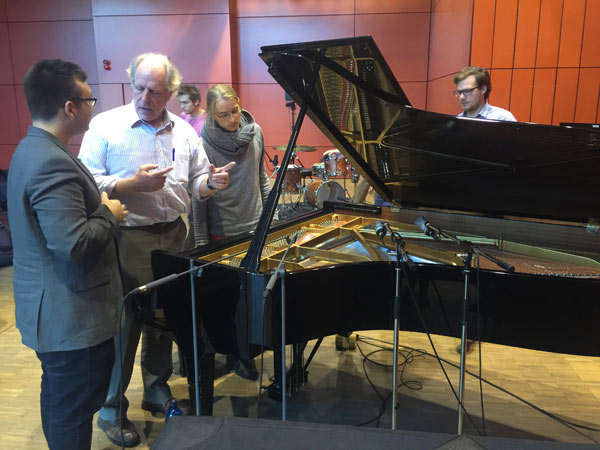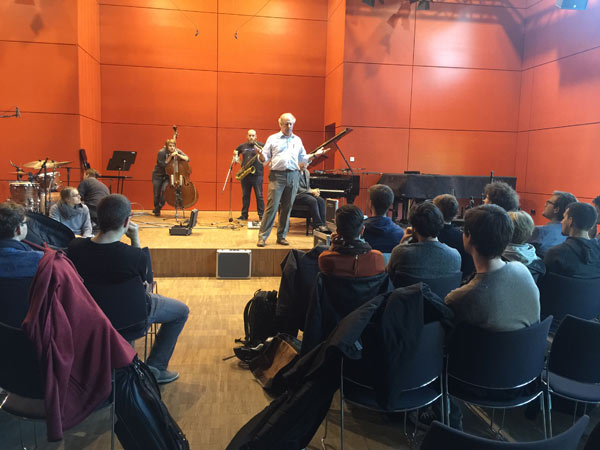A High-Resolution Session In Mainz
After the early presentation and demonstrations at the Johannes Gutenberg-Universität Mainz audio studio and lunch break, we setup a recording session in the large concert space at the school. The hall had a small stage with a couple of grand pianos and a harpsichord and an audience area containing about 300 moveable chairs. The plan was to record a jazz quartet demonstrating my miking techniques for the students.
Moritz and I went through their microphone cabinet and selected a variety of condenser and dynamic mikes includes some Schoeps MK 21s, Neumann 184s, a Sennheiser 421 for the kick drum, and a few AKG mikes. We selected 14 microphones to be deployed around a drum kit, acoustic bass, piano, and tenor saxophone.
The concert hall had tie lines connecting the main control room where Mortiz had an HD ProTools rig and a controller. I spent the next hour explaining to the students how to arrange the microphones around the instruments, why I chose the microphones, and why I place them as I do. Most of the students had no real experience setting up microphones and weren’t terribly comfortable with the whole situation…but we managed.
We started with the piano. I’ve written extensively on how and why I mike a grand piano as I do. Despite the contrary opinion of some amateurs, I’ve found the best sound…the most realistic sound…can be captured by placing two stereo pairs of microphones inside the instrument. I use a pair of small diaphragm condenser mics (a couple of Schoeps in this case) in an XY stereo configuration on the highest range of the piano and a couple of large diaphragm condensers in an ORTF configuration over the power part of the piano harp.
This guarantees an intimate sound and the flexibility to create mixes with both narrow and expansive spatial presentations. Choosing to use a single stereo pair at some distance from the piano limits options during the postproduction phase of a project. In addition, having the microphones “close up” means that the ultimate delivery system…the speakers…become the location of the piano. I prefer listening to a piano from about 10 feet away…other may prefer the sound sitting further. The students and pianist seemed to agree that the sound of the piano was particularly compelling.
I placed another stereo pair of large diaphragm Rode condensers on an ORTF pair in front of the acoustic bass just above the bridge. The use of a stereo pair opens the overall sound from a point source to a 3 dimensional sound image. When tracks were in limited supply, using a single microphone was a requirement…not anymore.
We used 7 microphones for the drums. The kick drum, high hat, snare, high tom, and floor tom each got their own mic and track (Sennheiser 421, KM-184s and an AKG 414 in order). A pair of Schoeps omni-cardioid MK21s on a long stereo bar were placed in a wide ORTF pattern over the top of the drummer.
Finally, a single Neumann U-87 was placed directly in front of the tenor saxophone player above the bell and about 18 inches away.
Several of the students plugged in all of the microphones according to chart Moritz provided and we returned to the control room for some initial sound checks.
To be continued.




Hi Mark, I really like to thank you for taking the time and sending these posts. I’ve been reading them every night since I’ve subscribed to you, keep up the good work.
Thanks Ron…more to come.
I am neither a musician nor a sound engineer.
But I know when I listen to some recordings (esp recordings of classical orchestral pieces) I sometimes feel the sound is lost some where inside the speakers. Volume increases do not help. It is like hearing an open-air concert a block away. I have read that some sound engineers thought a single mike hung from the ceiling at the back of the theatre is good. Personally I have strong suspicicions that that sort of philosophy is what has produced these “lost orchestra” recordings.
In other recordings, all the instruments seem spread across the space between my speakers. In some surround recordings sometimes some of the music even seems to be coming down frrom my ceiling!!!
I have some stereo recordings that even sound like that, even when played just through my front left and right speakers.
I have some Aix and Tacet surround recordings that sound even more like that. Total immersion in the music.
And with no knowledge or experience whatsoever, I am convinced that your multiple mikes, and close-up placement of mikes, is what results in “Presence” for the listener at the other end of the process.
Putting, nay – demonstrating – these concepts to a group of sound engineering students seems to me the best way of ensuring that future recordings succeed in bringing that “in the room presence” to us, the listeners.
Great work!!
Thanks…the feedback from the group in Mainz was very positive. I simply wanted them to see and experience a slightly different way to record. I like the sound of close up…others prefer far away.
Mark,
It’s good to know there’s people like you who are so generous sharing your vast experience and knowledge with future generations of audio engineers. I’ve always been of the school of thought that an EQ is overused in consumer audio equipment. Typically if you need an EQ, something is wrong, all they’re doing is adding another source of unwanted noise. Most sound guys in small venues the EQ is a necessity here, but more often than sound is over attenuated rather than cut. I’ve learned a lot from your posts and it’s opened my mind up to new and far better mic techniques. I’m not sure why, but most of the venues I’m referring to the signal usually is way too hot especially in the 1-2 KHz range. I’m assume they’re trying to “fatten up” the vocals. The biggest challenge is trying to point it out to whom ever is running the board without offending them. I have to wonder if they’ve suffered hearing damage from listening too loud for too long. Do you, or any fellow readers, have any suggestions for broaching this subject? It’s even been a problem when I’m playing-the last thing I need is to sound worse!
Steely Dan used zero EQ on their 2nd album, opting to spend their money on the best microphones and the best studio they could find. There’s a big lesson there. For larger concerts I always try to get seats close to the board, it seems to be the sweet spot. I lucked out for the last two concerts, Alan Parsons & Steely Dan getting those seats at both. The sound engineer at Steely Dan had a dummy tablet set up showing a unrealistically flat RTA discouraging any audience input which I found hilarious. I’d never question anyone Fagan & Becker would hire (unless it’s after the show and they’re willing to answer questions that’d enhance my knowledge)!
I don’t care who’s performing, I’m not risking my hearing due to someone who chooses loudness over quality.
The more I read of the Dr’s blogs, the more awed I am by what goes into producing a finished, first rate AIX recording. It’s no wonder so few companies are doing them. I didn’t recall reading the meaning of ORTF so did some research… just enough to not be ignorant but not enough to get in trouble. Here’s a link for those interested: http://www.harmonycentral.com/articles/ortf-stereo-microphone-technique.